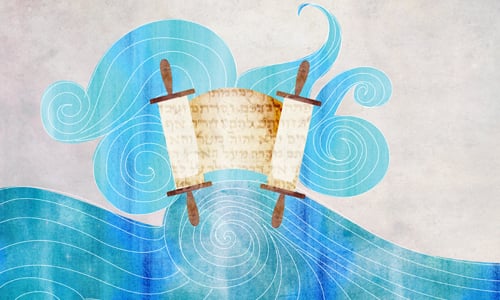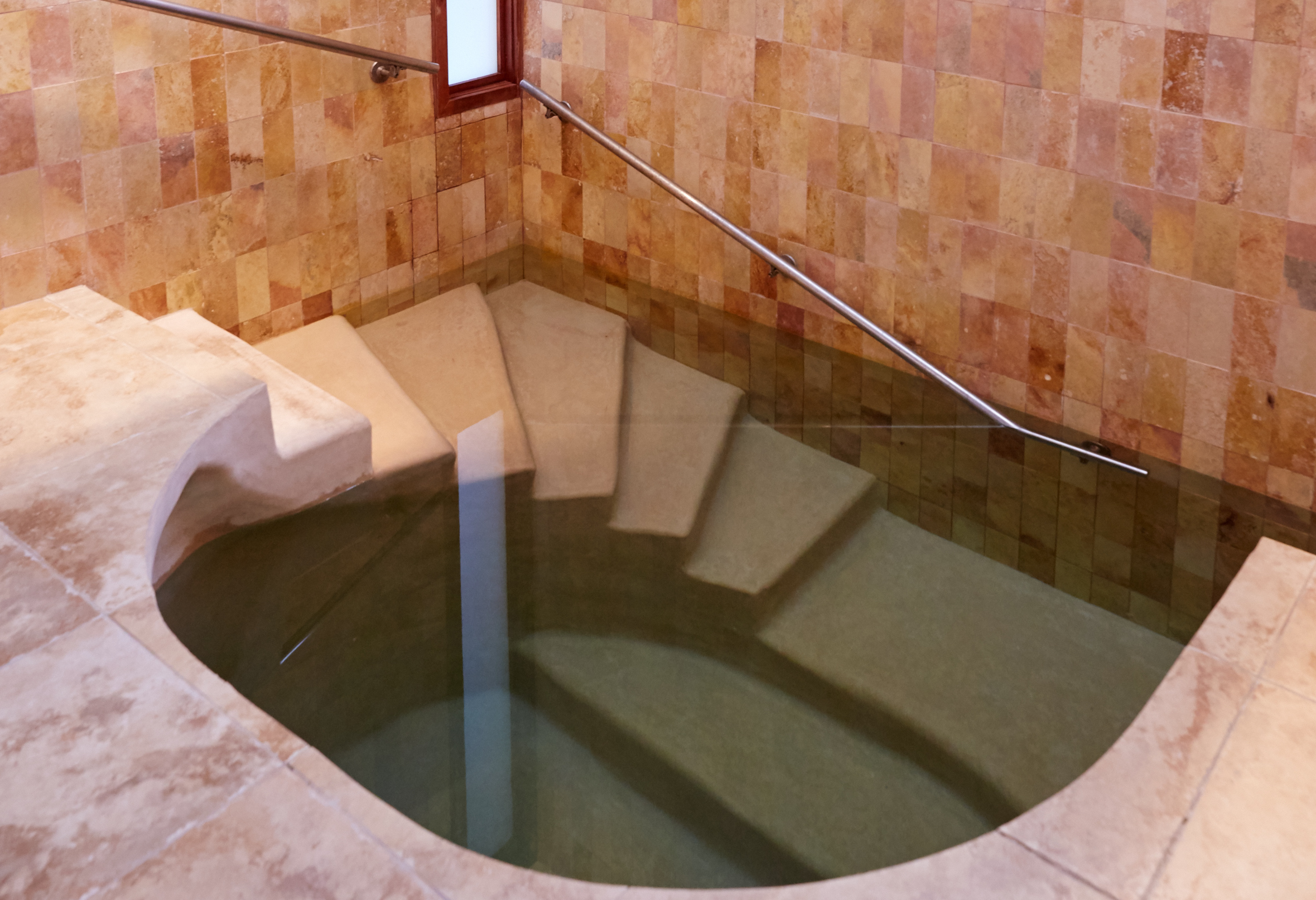#35 Mikveh – A Jewish Ritual Bath
#30 Mikveh – A Jewish Ritual Bath
 Mikveh or mikvah (Hebrew: מִקְוֶה / מקווה, Modern: mikve, Tiberian: miqweh, pl. mikva’ot, mikvoth, mikvot, or (Yiddish) mikves, lit., “a collection”) is a bath used for the purpose of ritual immersion in Judaism to achieve ritual purity.
Mikveh or mikvah (Hebrew: מִקְוֶה / מקווה, Modern: mikve, Tiberian: miqweh, pl. mikva’ot, mikvoth, mikvot, or (Yiddish) mikves, lit., “a collection”) is a bath used for the purpose of ritual immersion in Judaism to achieve ritual purity.
Most forms of ritual impurity can be purified through immersion in any natural collection of water. The mikveh provides a bathing facility that remains in contact with a natural source of water. The Mishna (Jewish code of law) describes in elaborate detail the requirements for ritually proper water and for the quantity of water required for ritual cleansing.
The existence of a mikveh is considered so important that a Jewish community is required to construct a mikveh even before building a synagogue, and must go to the extreme of selling Torah scrolls or even a synagogue if necessary, to provide funding for its construction.
#1 WATCH: What is a Mikvah?
#2 Building and Running a Mikveh
 The traditional rules regarding the construction of a mikveh are based on those specified in classical rabbinical literature. According to these rules, a mikveh must be connected to a natural spring or well of naturally occurring water, and can be supplied by rivers and lakes which have natural springs as their source. A cistern filled by the rainwater is also permitted to act as a mikveh’s water supply so long as the water is never collected in a vessel. Similarly snow, ice and hail are allowed to act as the supply of water to a mikveh no matter how they were transferred to the mikveh. A river that dries up upon occasion cannot be used because it is presumed to be rainwater and not spring water, which cannot purify while in a flowing state. Oceans and seas for the most part have the status of natural springs.
The traditional rules regarding the construction of a mikveh are based on those specified in classical rabbinical literature. According to these rules, a mikveh must be connected to a natural spring or well of naturally occurring water, and can be supplied by rivers and lakes which have natural springs as their source. A cistern filled by the rainwater is also permitted to act as a mikveh’s water supply so long as the water is never collected in a vessel. Similarly snow, ice and hail are allowed to act as the supply of water to a mikveh no matter how they were transferred to the mikveh. A river that dries up upon occasion cannot be used because it is presumed to be rainwater and not spring water, which cannot purify while in a flowing state. Oceans and seas for the most part have the status of natural springs.
A mikveh must, according to the classical regulations, contain enough water to cover the entire body of an average-sized person; based on a mikveh with the dimensions of 3 cubits deep, 1 cubit wide, and 1 cubit long (1 cubit = about 45cm/18 inches), the necessary volume of water was estimated as being 40 seah of water (1 seah = 9 quarts). The exact volume referred to by a seah is debated, and classical rabbinical literature specifies only that it is enough to fit 144 eggs.
#3 WATCH: A Mikveh for Baby!
#4 STUDY: Preparing for Mikveh and Blessings During
 There is supposed to be no barrier between the person immersing and the water. The person should be wearing no clothes, jewelry, makeup, nail polish, fake nails, or grooming products on the hair or skin. For more observant Jewish women, an attendant will assure these requirements are met. Showering or bathing and carefully checking the whole body is, therefore, part of the religious requirements before entering the water of a Mikveh.
There is supposed to be no barrier between the person immersing and the water. The person should be wearing no clothes, jewelry, makeup, nail polish, fake nails, or grooming products on the hair or skin. For more observant Jewish women, an attendant will assure these requirements are met. Showering or bathing and carefully checking the whole body is, therefore, part of the religious requirements before entering the water of a Mikveh.
Once prepared, the Mikveh attendant will walk with the person to the mikveh. They will be in the room while the person emerges themselves in the pool. All parts of the body must be submerged (eyes open, mouth open, fingers and toes spread apart) in the water and blessings recited.
The Sephardic custom is to recite the blessing first and then submerge completely for a moment or two. Ashkenazic Jews usually submerge once, then recite the blessing, and then submerge either one or two more times. Many mikva’ot provide the text.
בּרוּךְ אַתָּה יְיָ אֱלהֵינוּ מֶלֶךְ הָעוֹלָם אֲשֶׁר קִדְשָׁנוּ בּמִצְוֹתָיו וְצִוָנוּ עַל הַטְבִילָה
Barukh atah Adonai Elohenu melekh ha’olam
asher kideshanu b’mitzvotav v’tzivanu al ha’tevillah.
Blessed are You, O Lord, our God, Ruler of the universe,
who has sanctified us with Your commandments and commanded us concerning the immersion.
After you have blessed and immersed, if you like, you can spend some time in the mikveh for personal reflection or prayer.
#5: Review and Response
1. What does the word mikveh mean?
2. What kind of water should be used to fill a mikveh?
3. How many steps are there in a mikveh? Why do you think this number is used?
4. Who can go to a mikveh? What are some of the reasons a person might want to go to a mikveh?
5. Would you think about going to the mikveh or a special event in your life?
Mikvot are all over the world. Enjoy this tranquil video of a new natural mikveh in Maui, Hawaii!
Need some help? We’re here for you. At any time, if you have any questions, please contact one of our teachers so we can help you. Also, at the end of the session, remember to review your responses in your Tamid Workbook so you can get credit for this lesson. Behatzlacha (Hebrew for good luck)! You can reach Christina at (646)360-0689 or connect@tamidnyc.org
